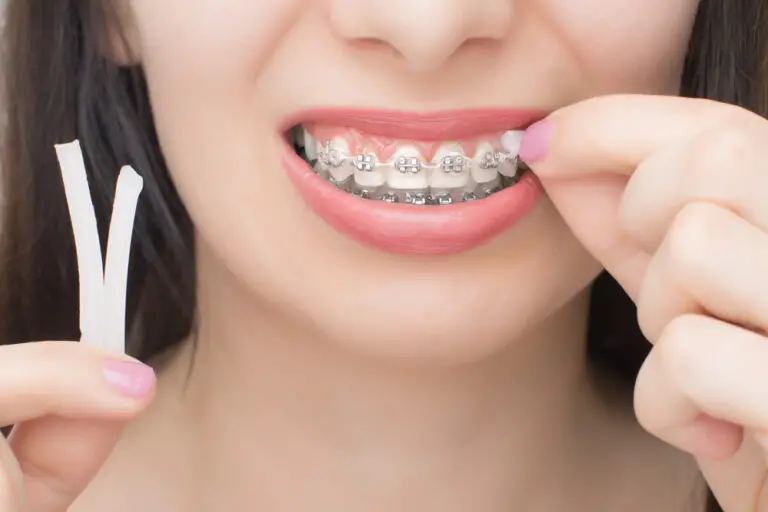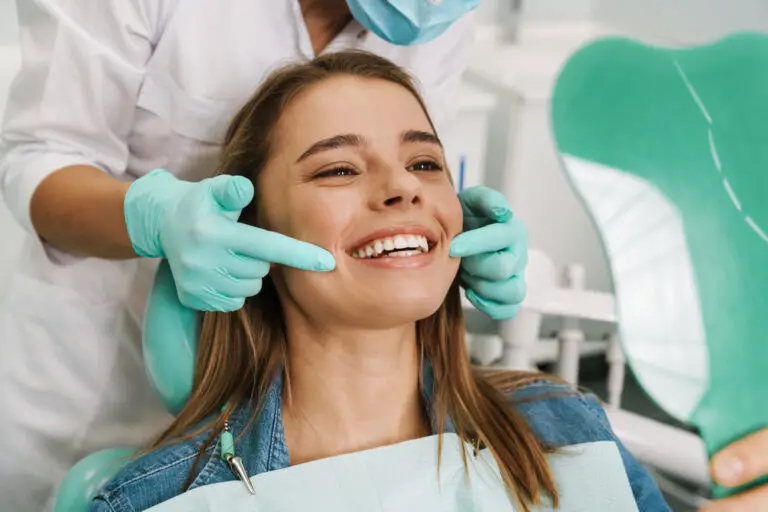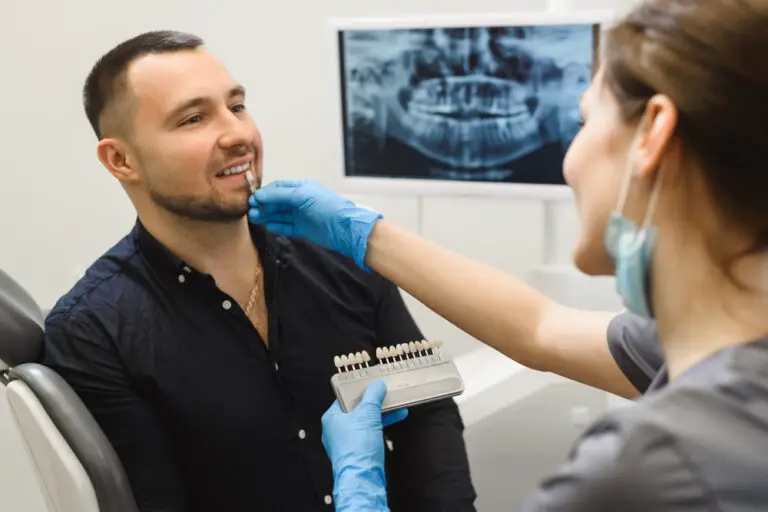Many people notice that their teeth look more prominent or larger in size as they get older. This can be an alarming observation, especially if you feel like your teeth are gradually taking over your face and smile! But in most cases, your teeth are not actually increasing in their true anatomical dimensions. There are several reasons why teeth often appear to get bigger with age. Understanding the main causes and risk factors can help you determine if your teeth are genuinely growing larger versus just seeming bigger due to other age-related changes in your mouth.
Your gums are receding
One of the most common reasons teeth seem to enlarge is due to gum recession. Your gums form a border of firm tissue around the base of your teeth. This gum tissue provides a foundation that frames and supports your teeth within the bony sockets of your upper and lower jaw.
As you get older, your gums are prone to shrinking back or receding, exposing more of the tooth surface that was previously covered. According to the American Dental Association, gum recession affects more than half of adults over age 30 to some degree. The following factors can cause your gums to recede incrementally over time:
- Gum disease – Periodontal infections break down gum tissue and supporting bone structures around the teeth. Chronic bacterial plaque accumulation inflames the gums and activates your immune system, resulting in damage to gum fibers and bone.
- Aggressive brushing – Habitual forceful brushing over many years gradually wears away gum tissue. Vigorous side-to-side scrubbing creates micro tears that can cause gums to recede.
- Poor oral hygiene – Inadequate plaque removal allows bacteria to constantly irritate gums. The inflammation causes structural changes in the gum fibers that make them weaker and more prone to shrinking away from the base of teeth.
- Smoking – Chemicals and carcinogens in cigarettes restrict blood flow to the gums. This limits delivery of oxygen and nutrients necessary to maintain healthy gum tissue and fight infection.
- Clenching and grinding – Putting excessive biting pressures on teeth when clenching or bruxing wears down gum tissue, which recedes to avoid the force. This compresses and thins gum fibers faster.
- Genetic factors – Some individuals are just genetically predisposed to more sensitive, delicate gum tissue that struggles to keep attached to teeth. They may experience progressive recession even with careful brushing and dental habits.
As your gum line recedes and pulls away from your teeth, it exposes more of the tooth crowns that were previously covered by gum tissue. This effectively makes your teeth look longer and increases visible tooth size. In more advanced cases of gum recession, the tooth roots can also become exposed as gums recede past the enamel-cementum junction. Seeing more tooth root surface further elongates the apparent tooth length.
Gum recession is often localized at first to areas most prone to irritation, like lower front teeth. But persistent sources of inflammation coupled with aging can cause gums to recede generalized around most or all teeth. The slower progression takes place over years and decades, so you may not notice the subtle changes. Compare some current photos to those from years ago – you may realize your gums don’t reach as far down on your teeth anymore.
You’re losing structural bone
Your teeth are anchored into your jawbone by bundles of collagen fibers called periodontal ligaments. These suspended attachments allow teeth to withstand the forces of biting and chewing. As you age, you naturally lose some of the bone minerals that provide foundational support for your teeth. This can make teeth shift slightly or appear looser and longer as they have less structural integrity holding them rigidly in place.
Some of the reasons you may experience gradual bone loss in the jaws include:
- Periodontal disease – Chronic bacterial inflammation directly destroys bone around the teeth as immune cells try to fight infection.
- Post-menopausal changes – When women reach menopause, decreased estrogen production accelerates bone loss. The jawbones are impacted same as other bones.
- Poor nutrition – Deficiencies in key nutrients like calcium, vitamin D and vitamin K negatively affect bone matrix health and remodeling.
- Medications – Drugs like oral steroids, anticonvulsants, blood pressure treatment and chemotherapy agents all interfere with optimal bone metabolism.
- Chronic inflammation – Systemic inflammatory conditions like rheumatoid arthritis break down skeletal bones including the delicate alveolar processes that house teeth.
As you lose the bony sockets around the base of your roots, it allows more microscopic mobility of the teeth. This exaggerated movement makes teeth seem longer and less stable when chewing. Bone loss from advancing periodontal disease also exposes more tooth length that was previously embedded in the bone for added stability.
Your lips are thinning

Full, plump lips provide an outer envelope of tissue that wraps around your upper and lower front teeth. When your face is relaxed, your lips act like a curtain that blocks exposure of the lower half of your teeth. As you enter your 40s and beyond, your lips tend to lose volume and fat, causing them to appear much thinner. This loss of lip fullness exposes more of your lower teeth even when your face and mouth are at rest.
Thinning lips and disappearing lip lines are largely due to natural changes associated with older age. But some additional factors can accelerate the loss of lip fullness, including:
- Smoking – Constant inhalation of toxic gases and chemicals restricts blood supply to the sensitive lip area. This deprives lips of oxygen and nutrients for optimal tissue health.
- Sun exposure – Ultraviolet radiation damages lip tissue fibers, causing dehydration and atrophy. Lips have very little melanin so are vulnerable to drying and shriveling effects.
- Dehydration – Inadequate daily water intake prevents lips from maintaining plump architecture supported by robust hydrostatic pressures.
- Vitamin deficiencies – Deficiencies in vitamins A, C, E, B2, and B3 lead to loss of lipids, moisture and muscle tone that support full lips.
Seeing much more of your lower teeth prominently displayed because of receding thin lips gives the illusion your teeth have increased in size. In reality, your lips can no longer obscure and disguise your lower teeth like they could in your younger years. Use of lip plumping gloss, hydration and potentially filler injections can help restore lost lip volume, diminishing appearance of elongated teeth.
Your teeth drift out of place
Teeth are held in a state of tight, precise contact and occlusal alignment by a balance of forces from lips, cheeks, tongue and jaw muscles. In adolescence and early adulthood, this equilibrium keeps teeth positioned firmly in the ideal arrangement. But as you get older, the natural balance is disrupted due to changes in gum and bone support tissues. This allows teeth to drift slightly out of position over decades.
Factors that contribute to gradual teeth drifting and movement include:
- Missing teeth – Loss of back teeth eliminates the stabilizing, bracing effect of having a full arch of occlusal contacts. This imbalance allows shift of remaining teeth.
- Uneven chewing – If you chew mostly on one side due to missing or painful teeth on the other side, the unequal forces cause teeth to shift toward the preferred side.
- Abnormal wear- Loss of enamel from bruxism, abrasion or acid erosion alters the tooth contours that guide proper alignment.
- Weakened bone – Periodontal disease destroys the fibers that anchor teeth firmly into bony sockets, enabling movement.
As the positioning of your upper and lower teeth slowly changes, the points of contact and overlap with opposing teeth are altered. Teeth that drift out of position often flare outward, spread apart from adjacent teeth or over-erupt. This makes them look bigger and longer since they are no longer contained in their original ideal arch form. Minor tooth drifting may not always affect function, but can be noticeable in a “gummy smile”. More significant changes often require braces or Invisalign treatment from your dentist to restore proper alignment.
Your perception is changing
In some cases, your teeth aren’t actually growing or getting bigger in their true sizes. But your visual perception of their size compared to your facial features has changed because of natural aging processes. Some reasons your brain may now interpret your teeth as larger include:
- Aging skin – Nasolabial folds, marionette lines, sagging jowls, and wrinkled skin around the mouth make teeth look more prominent. Youthful full facial fat pads and skin elasticity provided camouflaging effects.
- Weight loss – Slimming and thinning of the cheeks and lower face from fat loss or muscle atrophy removes layers of tissue that used to partially cover and mask teeth.
- Teeth whitening – Removal of years of accumulated stains inherently makes teeth look larger and brighter. Darker yellowed teeth blend into surrounding oral tissues.
- Gum reshaping – Esthetic procedures like crown lengthening or gum contouring better expose true tooth length but remove gingival coverage.
- Orthodontic alignment – Straightening with braces or Invisalign creates properly aligned arches where teeth stand out individually. Before braces, crowded overlapping teeth appeared smaller collectively.
If your dentist confirms there are no major measurable or clinical changes in your tooth sizes, then it’s likely minor aging changes are just altering your visual perception. Maintaining proper oral posture and tongue position can also give the illusion of smaller teeth. But some natural aging effects on gums and bone are unavoidable. Discussing cosmetic options with your dentist can help if your teeth’s appearance really bothers you.
Contributing health factors
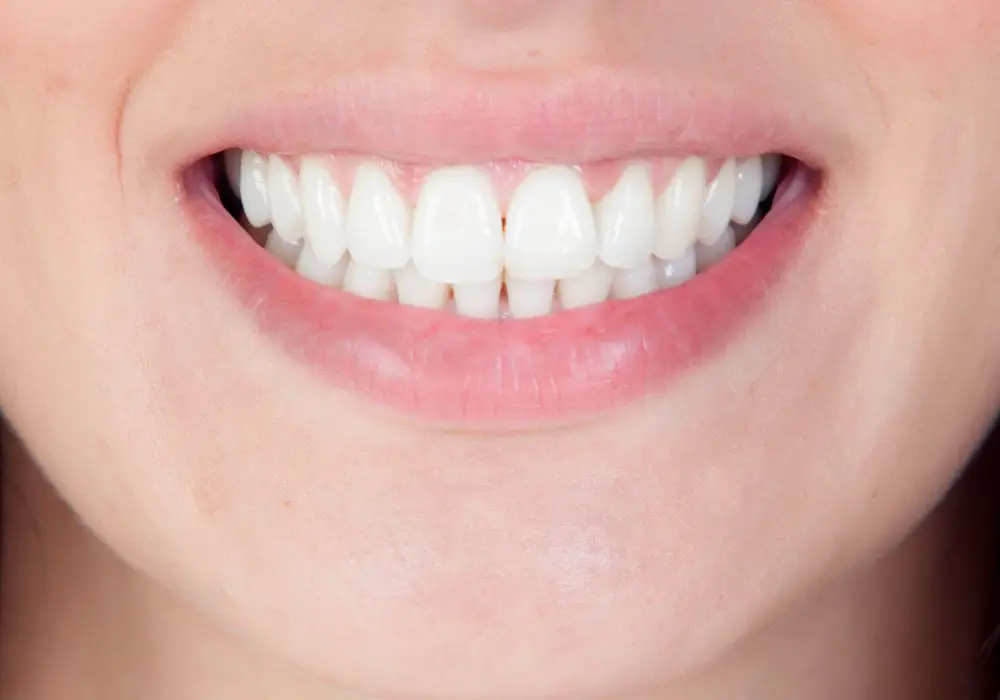
In addition to the common aging factors, some underlying medical or mental health conditions may hasten changes resulting in teeth appearing bigger. Be sure to discuss these concerns with your dentist and physician:
- Bulimia – Frequent purging and vomiting erodes enamel and inflames gums.
- Gastroesophageal reflux – Stomach acid entering mouth damages teeth and gums.
- Celiac disease – Nutritional deficiency affects dental and oral health.
- Hypermobility disorders – Excessive ligament laxity allows teeth to drift and shift.
- Sjogren’s syndrome – Autoimmune disease causes chronic dry mouth and increased decay risk.
Your healthcare providers can help diagnose and manage such conditions to limit their impact on symptoms of worsening tooth appearance. Keeping up with regular dental cleanings and checkups is important if you have any underlying medical issues.
When to see your dentist?
You should make an appointment to see your dentist promptly if you observe any of the following persistent signs that suggest your teeth may be increasing in visible size:
| Symptom | Potential Cause |
|---|---|
| Teeth sensitivity | Receding gums exposing roots |
| Teeth feel loose or wiggly | Lost bone support |
| Changed bite alignment | Shifting teeth positions |
| Red, swollen, or bleeding gums | Gum inflammation or periodontal disease |
| Tooth surfaces appear thinner | Enamel loss due to acid, abrasion, or erosion |
| Jaw soreness or tension | Clenching or grinding problems |
Your dentist can perform measurements and imaging to help determine if your tooth crowns or roots have increased in their anatomical dimensions, or if perceived changes are only due to aging effects on soft tissues. X-rays, periodontal charting, and impressions can also diagnose progression of gum recession or bone loss.
If any underlying dental problems are found, prompt treatment can help stabilize your oral condition and appearance. Recommended treatments may include gum grafting procedures, occlusal adjustment, nightguards for bruxism, or clear aligners to straighten drifted teeth.
For thinning lips, wrinkling skin, or other facial changes that are contributing to making your teeth look more noticeable, your dentist may advise consulting a dermatologist or plastic surgeon. Injectable fillers, chemical peels, laser resurfacing, or surgical facelift techniques could provide cosmetic improvement if you are very bothered by apparent tooth elongation.
Preventing further size changes
To minimize noticeable changes in tooth appearance and slow any processes making teeth seem bigger, be diligent about these daily oral care practices:
- Brush with care – Use a soft or extra soft bristled toothbrush. Avoid aggressive scrubbing and concentrate on massaging the gumlines to prevent receding gums.
- Floss thoroughly – Use proper flossing technique to remove plaque from between teeth instead of just snapping floss in place. This minimizes gum inflammation that causes tissue breakdown.
- Use antibacterial rinse – Choose a therapeutic mouthwash to reduce bacteria missed by brushing and flossing. This protects gums from persistent irritants.
- Wear a night guard if needed – If you clench or grind your teeth, talk to your dentist about having a custom nightguard made to protect them from pressure damage and excessive wear.
- Get professional cleanings – Regular prophylaxis appointments allow complete calculus removal above and below the gumline for optimal gingival health.
- Stop smoking – Giving up smoking improves circulation to gums and is one of the best things you can do for your oral health and appearance.
- Stay hydrated – Drink plenty of water to keep your mouth, gums and lips moisturized. Proper hydration fights inflammation.
- Eat a balanced diet – Nutrient-rich foods including calcium, vitamins C and D, magnesium and lean proteins promote gum and bone strength.
- Practice good oral posture – Train your tongue to rest in the proper position against the palate instead of pushing against teeth. This minimizes uneven pressures that cause flaring and shifts.
Following these guidelines can help you care for your gums, protect your bone density, and reduce risk factors that make teeth appear to enlarge. But even if you do everything right, some changes are inevitable with this complex aging process. Talk to your dentist sooner than later if you have any concerns about your tooth size for the best chance of intervention and correction.
Cosmetic treatments
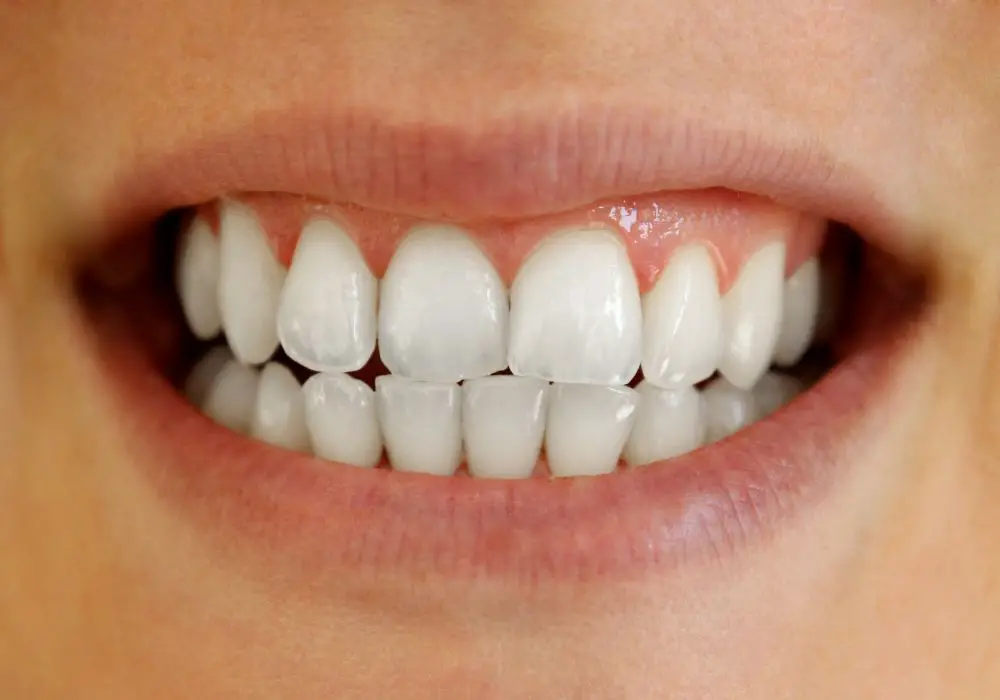
If your dentist determines your mouth is functionally healthy but you remain dissatisfied with dental aesthetics, consider these cosmetic treatment options:
- Tooth whitening – Removes stains that can make teeth blend together. Brightening makes them stand out more.
- Enamel shaping – Subtle slenderizing of thicker teeth can give a more proportional look.
- Gum contouring – Reshaping uneven gum margins makes gumline symmetrical and can show more tooth.
- Veneers or crowns – Thin porcelain or ceramic facings mask smaller natural teeth.
- Clear aligners – Orthodontic trays straighten slightly crooked teeth that lean out.
Cosmetic dentistry techniques won’t necessarily make your teeth smaller. But they can reduce the visual impact of dental changes that occur with age. However, these are elective procedures – don’t feel pressured to undergo unnecessary treatment because of natural minor changes in tooth appearance.
Frequently Asked Questions
1. Are my teeth still erupting from the gums as I age?
No. Adult teeth are already fully erupted, so they do not continue to physically emerge more from the gums over time. The perception is due to gum recession and bone loss uncovering more of the natural tooth length that was previously hidden below the gumline.
2. Can receding gums and lost bone grow back?
Minor gum recession can sometimes be reversed through professional scaling and root planing, along with improved oral hygiene. But moderate to advanced gum loss requires soft tissue grafting to try rebuilding lost gum tissues. Lost bone support generally cannot be directly regenerated but preventive dental care helps maintain the bone that still remains.
3. Do teeth expand in size on their own as I age?
Teeth do not typically expand in their anatomical dimensions after full eruption into the mouth during adolescence. But excessive attrition from bruxism, acid wear, or aging can thin the enamel layer, exposing more dentin and making teeth appear slightly wider.
4. Why don’t dentures and implants have this problem?
Dentures and dental implants are not anchored to gum tissues and living alveolar bone like your natural teeth. So they are not subject to gradual drifting, loosening, or gum and bone changes that can expose more tooth structure over decades. Their position remains fixed and stable once placed.
5. Should I just get all my teeth pulled so they can’t look bigger?
Extraction is not recommended for managing changes in tooth appearance with age. Pulling healthy natural teeth can lead to bone loss, collapsed facial features, and chewing impairment. There are many less invasive cosmetic options to consider that allow you to retain your natural dentition.
Conclusion
While your teeth are likely not increasing in their true anatomical size, normal aging changes in the gums, bone, lips and facial features can shift perception so teeth seem bigger and more prominent in the mouth and smile. Gum recession, bone loss, and thinning lips all play a role in exposing extra tooth structure instead of covering it like in youth. Keep up with regular professional cleanings and daily oral hygiene to protect your gum health and structural foundation. If excessively enlarged teeth don’t respond to preventive dental treatments and remain a significant cosmetic concern, discuss additional cosmetic options with your dentist.


